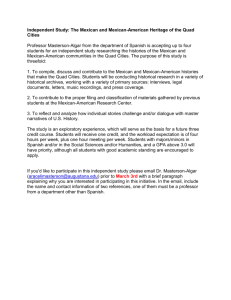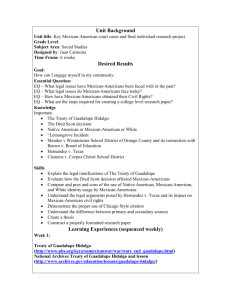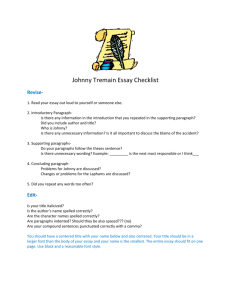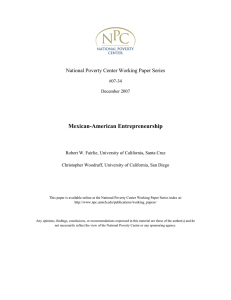Assessment Form
advertisement
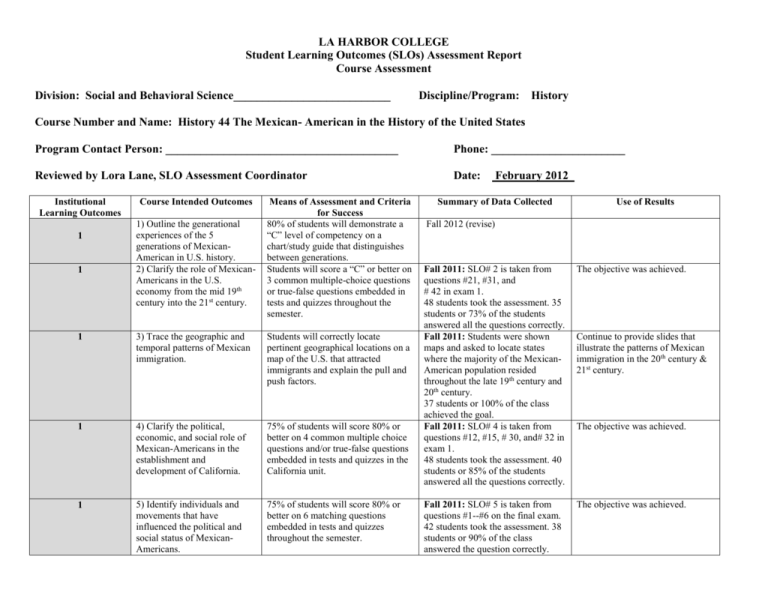
LA HARBOR COLLEGE Student Learning Outcomes (SLOs) Assessment Report Course Assessment Division: Social and Behavioral Science___________________________ Discipline/Program: History Course Number and Name: History 44 The Mexican- American in the History of the United States Program Contact Person: ________________________________________ Phone: _______________________ Reviewed by Lora Lane, SLO Assessment Coordinator Date: Institutional Learning Outcomes 1 1 Course Intended Outcomes 1) Outline the generational experiences of the 5 generations of MexicanAmerican in U.S. history. 2) Clarify the role of MexicanAmericans in the U.S. economy from the mid 19th century into the 21st century. Means of Assessment and Criteria for Success 80% of students will demonstrate a “C” level of competency on a chart/study guide that distinguishes between generations. Students will score a “C” or better on 3 common multiple-choice questions or true-false questions embedded in tests and quizzes throughout the semester. 1 3) Trace the geographic and temporal patterns of Mexican immigration. Students will correctly locate pertinent geographical locations on a map of the U.S. that attracted immigrants and explain the pull and push factors. 1 4) Clarify the political, economic, and social role of Mexican-Americans in the establishment and development of California. 75% of students will score 80% or better on 4 common multiple choice questions and/or true-false questions embedded in tests and quizzes in the California unit. 1 5) Identify individuals and movements that have influenced the political and social status of MexicanAmericans. 75% of students will score 80% or better on 6 matching questions embedded in tests and quizzes throughout the semester. February 2012 Summary of Data Collected Use of Results Fall 2012 (revise) Fall 2011: SLO# 2 is taken from questions #21, #31, and # 42 in exam 1. 48 students took the assessment. 35 students or 73% of the students answered all the questions correctly. Fall 2011: Students were shown maps and asked to locate states where the majority of the MexicanAmerican population resided throughout the late 19th century and 20th century. 37 students or 100% of the class achieved the goal. Fall 2011: SLO# 4 is taken from questions #12, #15, # 30, and# 32 in exam 1. 48 students took the assessment. 40 students or 85% of the students answered all the questions correctly. The objective was achieved. Fall 2011: SLO# 5 is taken from questions #1--#6 on the final exam. 42 students took the assessment. 38 students or 90% of the class answered the question correctly. The objective was achieved. Continue to provide slides that illustrate the patterns of Mexican immigration in the 20th century & 21st century. The objective was achieved. 1 6) Formulate a chronology of the major events in MexicanAmerican history. 90% of class will correctly place major 6 major events in correct chronological order. Fall 2011: 63% of students scored a “C” or better on the timeline. 1 7) Analyze the effects of 19th and 20th century institutions (legal, educational, religious) on the Mexican-American. Fall 2011: SLO#7 is taken from the final essay question #2. 42 students took the assessment. 38 students or 90% of the class scored a “C” or better. 1 8) Compare the experiences of Mexican-Americans with other ethnic groups in America before and after the Civil Rights Movements of the 1960s. 80% of students will demonstrate a “C” level of competence on an essay question explaining the effects of 19th and 20th century institutions on the 4 distinct Mexican-American generations in U.S. history. 80% of students will demonstrate a “C” level of competence on short answer questions that examine the cross-cultural experience of Mexican-Americans. 3 9) Identify and locate primary and secondary sources that are pertinent to the study of Mexican American history. 10) Interpret the MexicanAmerican in U.S. development. Students will score 80% on an analysis of a primary source, which will be scored according to department rubric. Students will discuss a historical site, film, or book that pertains to the experience of Mexican-Americans in the United States. Fall 2011: 37 students submitted the assessment. 30 students or 81% of the class scored a “C” or better on the primary source paper. Fall 2011: Students discussed the following film Mendez V. Westminster and were asked to write on the significance of the case in the Civil Rights Movement. 37 took submitted the assessment. 29 students received a “C” or better, 78%. 1 Fall 2011: 34 students out of 35 students or 97% of the class scored a “C” or better on the assessments. The objective was not achieved. Provide students with more class time to discuss major important historical events in class. Create discussion groups. The objective was reached. However, will make this essay question required for all students. Discuss some writing strategies on developing strong thesis statements. The objective was achieved. The objective was achieved. The objective was achieved. Date: 9/20/08 Institutional Learning Outcomes 1 Course Intended Outcomes 1) Differentiate between the current and former schools of Mexican-American historiography. 1 2) Clarify the role of MexicanAmericans in the U.S. economy from the mid 19th century into 21st century. 1 3) Trace the geographic and temporal patterns of Mexican immigration. 4) Clarify the political, economic, and social role of Mexican-Americans in the establishment and development of California. 5) Identify individuals and movements that have influenced the political and social status of Mexican- Americans. 1 1 1 6) Formulate a chronology of the major events in MexicanAmerican history. 1 7) Analyze the effects of 19th and 20th century institutions (legal, educational, religious) on the Mexican-American. 8) Compare the experiences of Mexican-Americans with other ethnic groups in America. 1 3 9) Identify and locate primary and secondary sources pertinent to the study of Mexican- Means of Assessment and Criteria for Success 80% of students will demonstrate a “C” level of competence on 3 multiple choice questions embedded in the test on the trends in the historiography of Mexican American History. 80% of students will demonstrate a “C” level of competence on an essay explaining the economic role of Mexican-Americans in a specific period of U.S. history. 95% of students will correctly locate pertinent geographical locations on a map of the Western Hemisphere. 75% of students will score 80% or better on 10 common multiple choice questions embedded in tests and quizzes in the California unit. 75% of students will score 80% or better on 10 common multiple choice questions embedded in tests and quizzes throughout the semester. 90% of students will complete a chronological timeline that chronicles major events in Mexican-American history. 75% of students will score 80% or better on 10 common multiple choice questions embedded in tests and quizzes throughout the semester. 80% of students will demonstrate a “C” level of competence on an autobiographical essay that examines the cross-cultural experience of Mexican-Americans. 80% of students earn a 75% or better on an essay that examines primary sources. Summary of Data Collected Use of Results 83% of students correctly differentiated the 3 schools of thought in Mexican-American historiography. Clarify historical interpretations by applying to a specific historical event in Mexican-American history, comparing and contrasting the historical perspectives. Utilize study sheet to specify important legal precedents throughout the course. 69% of students correctly identified social movements and leaders of the 20th century that changed the status of Mexican Americans in the U.S. Incorporate more visual media to demonstrate the significance of individuals and movements. 66% of students correctly identified the effects of the 19th century laws on MexicanAmericans Provide more visuals such as timeline and primary sources in lecture. The class average score was 60%. Offer visual guides and examples distinguishing primary and secondary sources. American history. Provide instruction in terms of organizing and writing an analytical essay.
